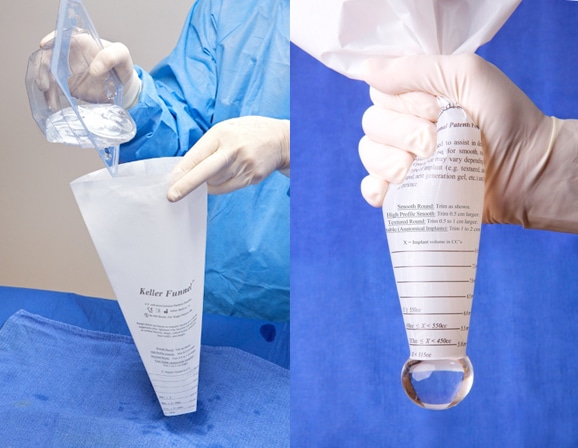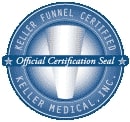Sometime in 2011, I was listening to the radio as I was driving home from work one night and heard a commercial by a respected colleague of mine. In this radio spot, the female announcer talked about his “new procedure” the “Dr. Smith’s Stealth Incision Breast Augmentation.” The announcer described how my colleague “sneaks breast implants into the breast through smaller incisions”. About one year later, I heard a similar radio commercial from the same surgeon. In this commercial, he renamed his procedure as “The Supershort Silicone Incision.” Presumably its the same procedure, now with a new name. Another colleague advertises “mini-incision” breast augmentation. Are these procedures the same thing? Are the incisions any different from what other plastic surgeons use? Let’s explore this a little.
Relationship Between The Incision Size, Ability Of The Surgeon To See What He/She Is Doing And Wound Healing
First, understand that wounds heal side to side, not end to end, so a shorter incision doesn’t heal any faster than a longer incision. Next, if a surgeon makes an incision so small that he/she can’t really see what they are doing, the risk of creating a breast pocket of improper dimensions and position goes up considerably. Would a surgeon operate in such a way that they cannot see what they are doing? The answer is yes, and this is done all the time in breast augmentation surgery. The technique is called “blunt dissection”. When the surgeon uses a very small incision, the only way to make the pocket is by blunt dissection, that is, inserting an instrument called a dissector (it looks like a “hockeystick”) into the breast. The pocket is then created by pushing and pulling and ripping the breast and muscle tissues, tearing them from the ribs, banging upon the ribs, causing bleeding, pain and prolonged recovery.
This method allows you to use a smaller incision, but with more bleeding and downtime. Then, through the incision, the surgeon will try his best to see inside to control the bleeding. If the incision is truly limited in size, then the surgeon’s ability to see and control any bleeding is also compromised. If the incision size is very small, then in order to see inside the wound, more force must be applied with retractors to permit visualization within the wound and this additional force on the tissue may result in poorer scar quality (as well as more post operative pain and downtime). A slightly longer scar that is thin and barely visible is more desirable than a slightly shorter, more visible scar.
This will translate into a higher rate of re-operation to correct these errors. One will never achieve a 24 hour recovery using this method, and the 3 year reoperation rate will be unacceptably high, typically around 20% or more. Using gentler techniques of surgical dissection, a much more favorable recovery with far lower reoperation rates (about 2%) can be achieved. That same colleague I referenced earlier, now almost a decade later, and to the best of my knowledge, is not performing breast augmentation with a one day recovery.
What exactly are we talking about here for incision size? I typically make a 4 cm (approximately 1.5 inch) incision for round, smooth silicone gel breast implants. I do not believe that they can be inserted with much less of an incision without risking damage to the implant, including risk of bursting or weakening them. So to save an extra 1 cm (4/10 inch), is it worth it to have all the extra pain, downtime and increased risk of needing a surgical revision? The increased bleeding that will occur with blunt dissection will also increase the risk of hardening of the breast, called capsular contracture. This makes no sense to me!
Incision Size and Saline Filled Implants
When saline filled implants are inserted, they are deflated and rolled up like a cigar and inserted into the breast. The saline implant is inflated only after it is inserted into the breast using a removable fill tube which attaches to the saline implant via a valve on the implant itself. After inflation, the fill tube is disengaged from the implant and the valve on the implant is sealed. For these implants, I typically use a 4 cm (approximately 1 1/2 inches) incision when using a breast crease incision. Can the implant be inserted through a smaller incision – the answer is yes. However, a 4 cm incision is modest in size, heals very well and with a barely visible scar in many cases. The reason I make a 4 cm incision is so that I can see what I am doing and avoid the necessity for blunt dissection and all the problems with pain, downtime and revision that come with it. So if you are making a smaller incision, perhaps 1 cm less than I use, what are you really saving?? If you wish to use a smaller incision, than you must be willing to accept the potential complications of doing so as described above.
Incision Size and Silicone Gel Filled Implants
With silicone gel implants, incision size is an entirely different ballgame. Unlike saline implants which are deflated when you open the package, silicone gel implants are prefilled by the manufacturer. This means that for a similar size implant (ie 300 cc), a silicone gel implant is much, much larger when it is inserted into the breast than a similar sized saline implant. Therefore, silicone gel implants typically require larger incision sizes than a saline implant. When a silicone implant is inserted, it is pushed into the wound using the fingertips of the surgeon, and the implant is deformed and squeezed until it enters the breast pocket. The manufacturers of these implants (Allergan, Mentor and Sientra) are very clear that the surgeon must “use an incision of adequate size” to place the implant. Just what is meant by “adequate size” is up to interpretation by the surgeon and basically is a size through which the implant can be easily inserted without too much deforming force and resultant stress on the implant which could otherwise weaken or cause it to burst. Typically incisions of 5 cm and upwards (depending upon implant size are required in most cases with these implants. Certainly, these incision lengths are greater than what the surgeon needs to properly visualize the pocket he/she is creating, but this is so due to the limitations imposed by the size of the implant, not the needs of the surgeon.
All this said, remember there is no absolute minimum incision size that is required for silicone gel implants. As long as the surgeon can put them into the breast without too much stress on the device, the incision size itself is not an issue. So, if one can find a way to insert the implant through a smaller incision and “lube it up” so that it slides in easily, the problem is solved: smaller incision and less trauma of insertion. Well, this has been done. It’s called the Keller funnel. This funnel looks like a paper pastry funnel. Among the differences between the Keller funnel and a pastry funnel is that the Keller funnel costs about $100 and you can only use it on one patient, then it is discarded. Also, the inside of this device has a special lubricant that results in less friction as the implant is inserted. It’s pretty ingenuous and very simple to use. Like a pastry funnel, it is tapered at the end. There are graduations on it marked with different implant sizes that tell you where to cut so that the opening is the smallest recommended opening for a particular sized implant. The surgeon inserts the opening of the funnel into the breast wound, squeezes behind the implant and “Voila!”, the implant “sneaks into the breast through a smaller incision! So, in reality, all my colleague is probably doing is using the Keller funnel to reduce the size of his breast implant incision! For most round silicone gel filled implants that I typically use, I can easily and safely insert these implants into the breast through the same 4 cm incision size that I use for saline implants!
Allergan 410 “Gummy Bear” implants do require a slightly larger incision because these implants are “form stable” (hold their shape) and do not deform as much as a round smooth silicone gel implant. They typically require a minimum incision length of 4.5 to 5 cm or they cannot be inserted with risk of fracturing the gel structure inside them.

Is the Keller funnel worth the extra cost? I think so, I did not raise my fees for breast augmentation when I started using these funnels in 2012. I do believe that among the advantages of the funnel, aside from a smaller incision size is less physical contact between my gloved hand and the implant, as well as far less trauma to the implant (and my hand!) during the insertion process. This can only be good for the longevity of the implant as well as the longevity of my hand! It’s a win – win situation for the both of us!

Sections – What Else Should I Know
- Breast Augmentation with Fat
- Will my breasts be symmetric?
- How far apart will my breasts be? Will I have cleavage?
- The truth about incision size
- Do breast implants need to be routinely changed?
- Things We Cannot Control: Wound healing, tissue stretch and gravity
- Breast Augmentation and Lactation
- Setting realistic expectations for your result
- Breast Implant Rupture – How To Know? – Are Routine MRI Scans Really Necessary?
- Mondor’s Cords – What Are They?
Prev Chapter: Breast Lift (Mastopexy) with/without Implants or Fat »
Next Chapter: Important Things to Consider When You Decide to Move Forward With Breast Augmentation »
Chapters – Breast Augmentation Guide
- Intro to Breast Augmentation
- Preservation Breast Augmentation – A New Era!
- Motiva Implants – What You Need to Know
- Five key decisions you need to make
- One-Day Recovery Breast Augmentation
- Anesthesia – General, Sedation or Local?
- Breast Lift (Mastopexy) with/without Implants or Fat
- What else should I know about breast augmentation?
- Important Things to Consider When You Decide to Move Forward With Breast Augmentation
- Revision of breast augmentation
- ALCL and Breast Implant Illness


